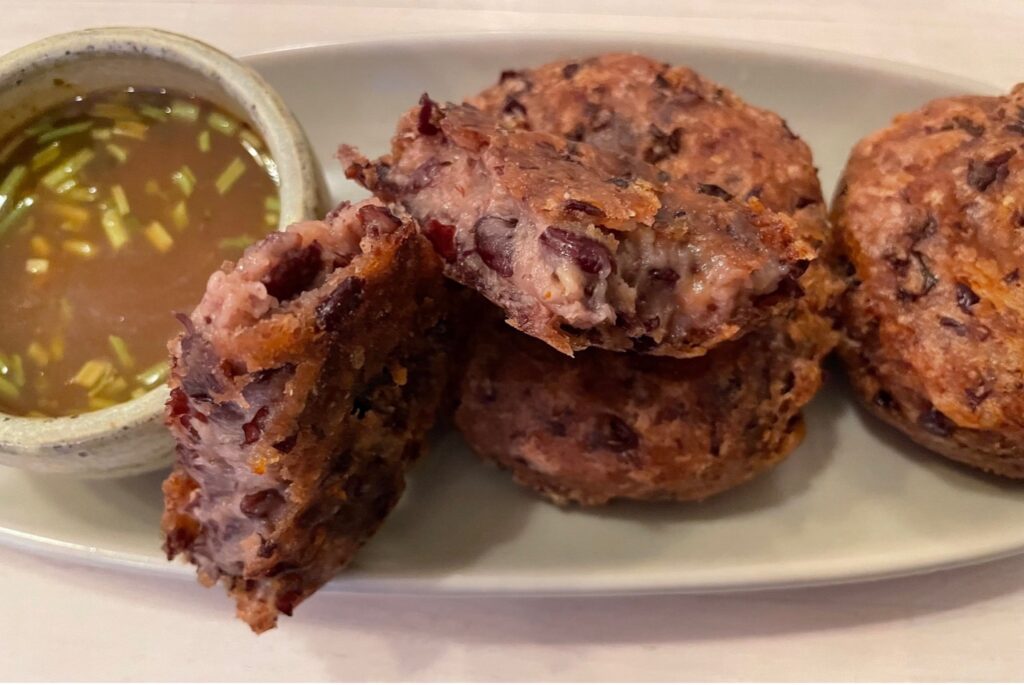Discovering a restaurant boasting authentic or traditional cuisine always sparks a surge of excitement and curiosity within me. It suggests that what awaits on the plate is as close as you can get without needing to travel. And who isn’t excited for that moment of truth from the very first bite, affirming the wisdom in choosing a new dining location? I know I was when I decided to have an early dinner afterwork at Rangoon in Brooklyn.
I embarked on a gastronomic journey to experience traditional Burmese cuisine, from the western part of Southeast Asia, in the heart of Brooklyn.
Formerly known as Burma, the country now bears the name Union of Myanmar since 1989. Reflecting this heritage, Rangoon, formerly Rangoon is now Yangon, the city that once served as Myanmar’s capital from 1948 to 2006. While globetrotting to culinary hotspots remains a dream, I’m fortunate to have access to exceptional chefs who infuse foreign cultures and historical narratives into their culinary creations. There’s a profound allure when such establishments are family-owned, embodying a sense of community gratitude and support for their courageous vision.
At Rangoon, by Chef Myo Moe and her husband, Daniel Bendjy, the tradition and heritage was of great importance for their vision.
Their journey from the inception of the Rangoon Noodle Lab pop-up in Bushwick to the current location of their restaurant speaks to their dedication and community support. Chef Myo’s recipes shine as she serves traditional Burmese dishes passed down through generations of her maternal lineage. This homage to her mother, grandmother, and great-grandmother’s recipes highlights each dish with an authentic energy that resonated with me.
Seated at the bar, I eagerly sought recommendations from fellow patrons. The Tamarind Limeaid, a refreshing non-alcoholic beverage, surprised and delighted my palate with its subtle sweetness and citrusy twang. Served with a sustainable straw, the commitment to eco-conscious practices is not lost.

The Laphet Thoke, a mix of fermented tea leaves, tomatoes, cabbage, peanuts, and beans, was a symphony of flavors, each bite made me more curious as too why I’ve never heard of this salad before. Lahpet, which means “green tea,” and thoke, which means “salad,” is historically an ancient symbolic peace offering that was exchanged and consumed after settling a dispute between warring kingdoms. Today, a lahpet tray is the traditional expression of hospitality offered to houseguests. The Burmese fermented tea leaf gave a light astringent flavor that blended nicely with all the other ingredients. I can not recall having had fermented tea before and assumed it would be tart, but it was not. Combined with diced juicy tomatoes, shredded cabbage, crispy peanuts, and fried beans, and mixed in were discrete slices of fried garlic. An entire theme park of flavors was happening with each bite I ate. This salad is vegan, gluten-free, and I believe only dressed with lime juice, yet misses nothing. The salad is by far one of my all-time favorite salads! It has a beautiful expression of the creative use of fresh vegetables without diluting the natural flavors with heavy salad dressing.

Mandalay bean fritters, Pae Kyaw, are red kidney bean fritters with tamarind-garlic dip. They were soft and fluffy inside and had the thinnest, crispest shell outside. Very generous size portions with three to an order. This item was also vegan and gluten-free, which proves healthier choices can be tasty too!
The Mohinga, a lemongrass fish noodle soup, was the finale to my savory dinner meal. Visually, it looked exactly like the photo on the website and was just as impressive to taste. With a thickened aromatic fish broth, thin rice noodles, one onion fritter made similar to the bean fritter, and an egg topping. Of course, I welcomed the house-made spices on the side for additional toppings and was pleased with each bite. Though I initially expected fish in the dish, the revelation that its essence lay solely in the broth didn’t detract from the overall experience. In fact, it deepened my appreciation for the dish’s fulfilling ability through the creativity of all.

The evening finished with Ohn-no Targu, a tapioca with coconut cream and shavings, dried rose petals, topped with fresh mint. Served with delightful turmeric agar jellies which added an earthy spice in combination with the richness of the milk. Very eye-catching and beautiful presentation in the elevated plate ware. I am glad I got the opportunity to try a different style of a dessert than I’m used to, and I look forward to seeing what other options appear in the future.
As I departed, boxes of leftovers and a heart full of delight, I wholeheartedly recommend Rangoon to fellow food enthusiasts. Its warm hospitality, coupled with a menu steeped in familial tradition, ensures an unforgettable dining experience.
